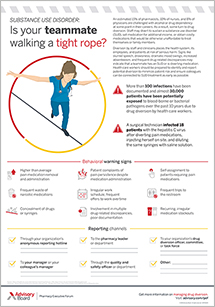Auto logout in seconds.
Continue LogoutDeaths from alcohol, drugs, and suicide—so-called "deaths of despair"—in 2017 hit the highest rate since CDC researchers began collecting data on the deaths two decades ago, according to an analysis from the Trust for America's Health and the Well Being Trust.
Your top resources for combatting the opioid epidemic in one place
The rise in deaths of despair
For the analysis, researchers examined CDC data dating back to 1999 when the agency first began tracking deaths related to alcohol, drugs, and suicide.
They found that deaths of despair had more than doubled since 1999, with more than 150,000 Americans dying from alcohol and drug-related deaths in 2017.
According to the analysis, the increase in drug-related deaths has been driven in part by the opioid epidemic, which has become the leading cause of death for Americans under age 55 over the past five years.
In 1999, fewer than 1,000 deaths were attributed to fentanyl and synthetic opioids. By comparison, last year, more than 1,000 Americans died from synthetic opioid overdoses every two weeks.
Nearly one-third of the over 150,000 deaths in 2017 were caused by suicide. The report found that suicide deaths by gun increased 22% over the past decade, and guns were used in almost half of the nation's suicides in 2017.
Meanwhile, suicides by suffocation increased by 42% over the past decade. John Auerbach, president and chief executive of Trust for America's Health, and Benjamin Miller, chief policy officer for the Well Being Trust, attributed that increase to copycat suicides. "People get the idea from high-profile celebrities who die by hanging," Miller said.
A strategy to rein in deaths of despair
Miller attributed the stark rise in deaths to growing disparities in both health care and income. "There are two crises unfolding in America right now," he said. "One is in health care, and one is in society."
Writing in STAT News, Miller and Auerbach argued that, in order to tackle this problem, the United States needs "to transform fragmented and disjointed community systems." To do so, they wrote the country needs "a comprehensive approach that includes increasing funding and support for programs that reduce risk factors for despair and promote resilience in children, families, and communities."
They added that exposure to trauma at a young age increases the potential for substance misuse and suicide. Therefore, programs that "reduce community violence; address poverty and discrimination; create safe, supportive schools and quality learning experiences; and promote access to secure housing and employment opportunities can decrease adverse experiences and build resilience."
They cited the Sobriety Treatment and Recovery Teams (START) program in Kentucky as an effective way to help parents get sober and, when possible, keep children safely with their parents. According to Miller and Auerbach, mothers achieve sobriety through START at almost twice the rate of mothers who are not in the program. In addition, children in START families were half as likely to end up in state custody as those not in the program.
"Continually rising deaths from despair and trauma are unacceptable and, perhaps most importantly, they are preventable," Miller and Auerbach wrote. They added, "Let's not wait for the next crisis, or ride out this one for another decade, to decide that now is the time to invest in prevention" (Hassan, New York Times, 3/7; Miller/Auerbach, STAT News, 3/5).
Access our top resources on the opioid epidemic
The opioid epidemic is a complex, multi-dimensional public health problem. Use this list of helpful resources on how hospitals and health systems can play a role to treat opioid addiction and prevent further increase in opioid abuse.
Don't miss out on the latest Advisory Board insights
Create your free account to access 1 resource, including the latest research and webinars.
Want access without creating an account?
You have 1 free members-only resource remaining this month.
1 free members-only resources remaining
1 free members-only resources remaining
You've reached your limit of free insights
Become a member to access all of Advisory Board's resources, events, and experts
Never miss out on the latest innovative health care content tailored to you.
Benefits include:
You've reached your limit of free insights
Become a member to access all of Advisory Board's resources, events, and experts
Never miss out on the latest innovative health care content tailored to you.
Benefits include:
This content is available through your Curated Research partnership with Advisory Board. Click on ‘view this resource’ to read the full piece
Email ask@advisory.com to learn more
Click on ‘Become a Member’ to learn about the benefits of a Full-Access partnership with Advisory Board
Never miss out on the latest innovative health care content tailored to you.
Benefits Include:
This is for members only. Learn more.
Click on ‘Become a Member’ to learn about the benefits of a Full-Access partnership with Advisory Board
Never miss out on the latest innovative health care content tailored to you.

